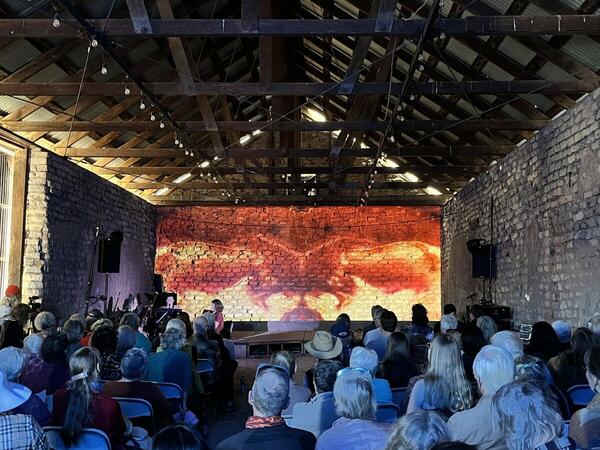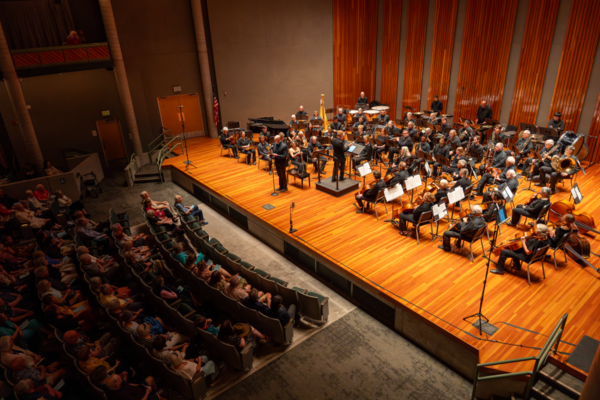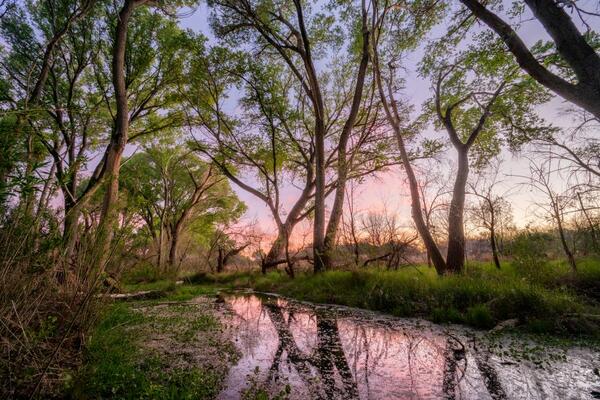Building Community Through Music, Art, and Watershed Science - The Watershed Soundscape Project
By Nicandro Guereque, Outreach Intern
Watershed Management Group, U of A Arizona Institute for Resilience, U of A School of Music
Is there any sound more beautiful than the sound of running water? There was a time when you could hear the sound of the Santa Cruz River and its tributaries flowing in Tucson. The Santa Cruz River supported the Indigenous communities that lived alongside it by providing food and irrigation for growing crops. As a result of urbanization, our rivers have changed dramatically. Now, this major watershed only flows when it rains.
As an effort to remember the history of the Santa Cruz watershed and emphasize the importance of keeping our desert rivers and tributaries alive, The Arizona Institute of Resilience (AIR), UA School of Music, and UA School of Art have come together and collaborated with Watershed Management Group’s River Run Network, to help commemorate our rivers in this Watershed Soundscape Project.
The Watershed Soundscape Project
Watershed Community Science and Art - The Sounds of Our Rivers

The Watershed Soundscape Project is a multidisciplinary concert series created to inspire a community of watershed stewardship through the fields of art, music, and science. As a result this project is led by collaborators from all three fields who are working closely with educators, artists, and local non-profit organizations to organize a concert series around a new composition. This project is led by principal investigator Sara Fraker (Associate Professor of Music), along with co-investigators Yuanyuan (Kay) He (Composer and Assistant Professor), Jackie Glazier (Associate Professor of Music), Larry Fisher (Research Professor Emeritus, SNRE), Alison Hawthorne Deming (Author and Poet), Neha Gupta, (Assistant Research Professor within AIR and the Department of Hydrology and Atmospheric Sciences), Carissa DiCindo (Associate Professor in the School of Art), Jacelle Ramon-Sauberan (Instructor at Tohono O’odham community college and Education Liaison for the Kitt Peak National Observatory) and multiple Watershed Management Group staff including Lauren Knight (River Run Network Program Manager), Lisa Shipek (Executive Director), and myself, Nicandro Guereque (Outreach Intern).
As a result of this project, a musical composition was created called Sonoran Rivers. This musical piece tells the story about the Santa Cruz River and Cienega Creek, the people who lived here, and the state that our river is in now. Parts of the piece were created using data from the River Run Network’s Flow365 Monitoring Program - where community members collect flow data on our creeks and rivers, and the wet-dry mapping done along Cienega Creek by the Pima Association of Governments, Bureau of Land Management, and The Nature Conservancy.
A consortium of high school, amateur, and professional ensembles participated in playing this composition across the Santa Cruz Watershed. The project team developed educational videos and activities to help educate the musicians playing the composition to engage them more deeply in our watersheds and provide background information for the development of the composition. You can watch the Sonoran Rivers Classroom Video series on YouTube.
Soundscape Composition Premieres and Sonoran Rivers
When I started my internship at Watershed Management Group, I was fortunate enough to hear the musical works premiered at Empire Ranch in the Las Cienega Natural Preservation Area where we gathered to listen in an Adobe Hay Barn. Composed by Carolina Heredia and accompanied by projections of earth pigment art created by visual artist Heather Bird Harris, the piece was played by a small group that consisted of the oboe, clarinet, and bassoon. Other works were performed by a combination of winds and strings.
 Before the start of the concert we heard an introduction from Dr. Jacelle Ramon-Sauberan, an instructor in San-Xavier community from the Tohono Oʼodham Nation who played a bridging role between local and ancestral community knowledge and outside organizations for the soundscape project. In her introductory remarks she reminded us that the Cienega Creek and the surrounding nature preserve was the ancestral land that belonged to the O'odham people and how the creek provided resources and safe space for them. She emphasized the history and sacredness of our creeks and rivers. She also shared an O'odham song created by O’odham elder and leader Danny Lopez that was about the O’odham creator, also referred to as big brother, “I'itoi” to lead into the concert. It was important to be reminded about the history of the areas and acknowledge that we were on the ancestral land of people who lived alongside our watershed. It was also very pleasant to hear the O’ohdam song sung by Jacelle and her nieces.
Before the start of the concert we heard an introduction from Dr. Jacelle Ramon-Sauberan, an instructor in San-Xavier community from the Tohono Oʼodham Nation who played a bridging role between local and ancestral community knowledge and outside organizations for the soundscape project. In her introductory remarks she reminded us that the Cienega Creek and the surrounding nature preserve was the ancestral land that belonged to the O'odham people and how the creek provided resources and safe space for them. She emphasized the history and sacredness of our creeks and rivers. She also shared an O'odham song created by O’odham elder and leader Danny Lopez that was about the O’odham creator, also referred to as big brother, “I'itoi” to lead into the concert. It was important to be reminded about the history of the areas and acknowledge that we were on the ancestral land of people who lived alongside our watershed. It was also very pleasant to hear the O’ohdam song sung by Jacelle and her nieces.
As part of this experience, we also received a tour of the Cienega Creek watershed. Having done the tour and listening to the premiere of the piece, the experience was very beautiful. The piece captured the visuals of the sprawling grasslands and rippling streams that I saw in the Las Cienegas National Conservation Area. The experience itself helped me to have a better understanding of our creek and the beauty of our desert rivers and riparian habitats.
 I was also grateful to listen to the Sonoran Rivers piece played by the Southern Arizona Symphony Orchestra at Catalina Foothills High School. What I heard at Empire ranch was a mashup of Alison’s text and an existing piece by Sergei Prokofiev titled Quintet Op.39. We heard four movements paired with Allison’s text. The fourth movement of the piece included a special section by Alison Hawthorne that the music by Prokofiev complimented so beautifully. Only having heard the narration by Allison at the Empire Ranch performance, it was amazing to hear the Sonoran Rivers piece paired with the text for the first time at the Catalina Foothills High School.
I was also grateful to listen to the Sonoran Rivers piece played by the Southern Arizona Symphony Orchestra at Catalina Foothills High School. What I heard at Empire ranch was a mashup of Alison’s text and an existing piece by Sergei Prokofiev titled Quintet Op.39. We heard four movements paired with Allison’s text. The fourth movement of the piece included a special section by Alison Hawthorne that the music by Prokofiev complimented so beautifully. Only having heard the narration by Allison at the Empire Ranch performance, it was amazing to hear the Sonoran Rivers piece paired with the text for the first time at the Catalina Foothills High School.
The piece includes eight movements total with each having a narration and text provided by poet Alison Hawthorne Deming. Each performance included a narrator from the University of Arizona to accompany the ensembles. At Catalina Foothills High School, Dr. Phillip Alejo did the narration alongside the high school ensemble. Each movement tells the story of our watershed, starting with the first movement: The Desert. A story is told via this and the following movements: Las Cienegas (The Marshes), The People, The City, and the final movement: The Music of the Future.
 The melody of the Las Cienegas movement is sprawling and serene, perfectly capturing the soundscape of Cienega Creek and the sound of moving water. In the following movement, titled The People, the tempo is faster and instrumentation is varied and more upbeat to represent the lively activity of the communities living near the watershed. Then it builds into a dramatic movement, The City, the key of the piece changes. It is no longer lively and becomes more ambiguous and ominous sounding, relating to the unknown the future holds for our watersheds. The final movement titled The Music of the Future says that the future is uncertain. It asks audiences to consider what work we will do to protect what we love.
The melody of the Las Cienegas movement is sprawling and serene, perfectly capturing the soundscape of Cienega Creek and the sound of moving water. In the following movement, titled The People, the tempo is faster and instrumentation is varied and more upbeat to represent the lively activity of the communities living near the watershed. Then it builds into a dramatic movement, The City, the key of the piece changes. It is no longer lively and becomes more ambiguous and ominous sounding, relating to the unknown the future holds for our watersheds. The final movement titled The Music of the Future says that the future is uncertain. It asks audiences to consider what work we will do to protect what we love.
Seeing how many people were involved in this project and the collaborative effort involved to bring more awareness to issues such as sustainability and climate change is very inspiring. When I started this internship it was surprising to see that faculty from the UA school of music were working with the Arizona Institute of Resilience to create a concert series. I didn’t realize that science could be used to help create a musical experience. Before I had thought that the fields of art and science were very separate. However, after listening to the Sonoran Rivers piece I realize that both can work well together when it comes to creating expressive pieces of media while also bringing more awareness to environmental. As a musician I believe in the power that art has in bringing change through the telling of stories. During this internship I became aware of the watershed stewardship efforts that were taking place in Pima county. These efforts make me hopeful that we can restore the habitats our Santa Cruz river provides. The hundreds of volunteers from the River Run Network that come out every week proves that people still care about the restoration of our watershed. I hope that the Sonoran Rivers piece is shared with others so that those who listen can be inspired to learn more about the disappearance of our rivers and ecosystems. That way it will move others to take action in watershed stewardship.The soundscape project shows how the arts can be important in promoting not only watershed stewardship but environmental action and awareness.
